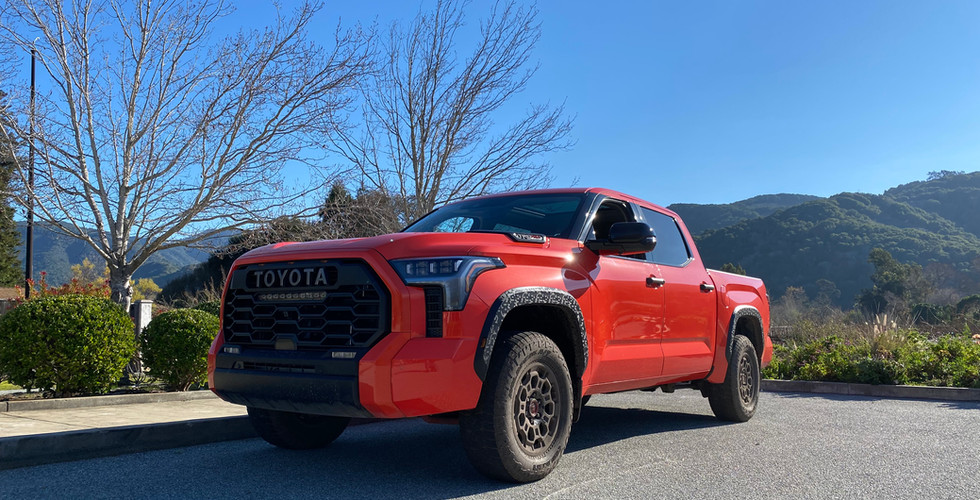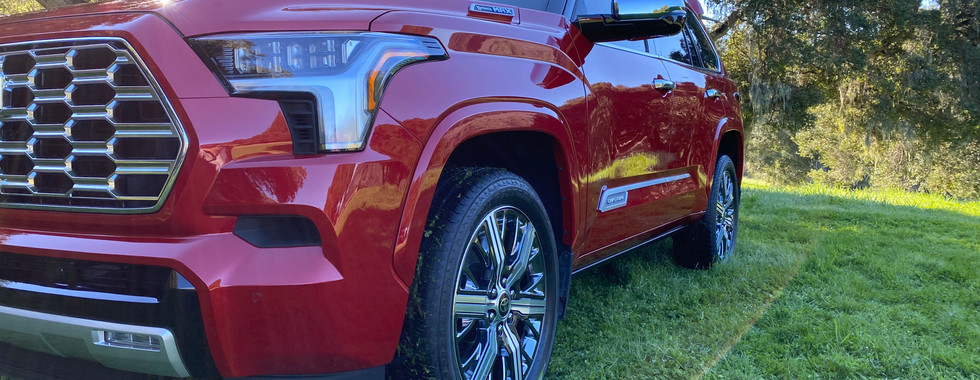iForce to the Max: Toyota Introduces Hybrid Power to the 2022 Tundra and Sequoia
- Erik JP Drobey

- Feb 2, 2022
- 5 min read

The folks at Toyota would like for you to believe that you can have it all with the 2022 Tundra iForce Max. And, you know, they’d be mostly right.
At Toyota’s invitation, I spent two days driving several trims of the brand’s latest body-on-frame truck, all powered by a twin turbo 3.5-liter V6 paired with a new parallel hybrid system (hence the moniker iForce Max). With the Tundra, I cruised on the highway, twisted through valley roads, towed an Airstream, and crawled over some serious terrain. In every (curated) scenario, the Tundra excelled, with surprising comfort and style to boot (surprising to me, at least).
Power and Grunt
I have not driven the previous generation Tundra, and therefore cannot compare the new powertrain with the 5.7-liter V8 engine it replaces. I can say, however, that the new iForce Max Tundra is not wanting for power or grunt. The twin-turbo V6 hybrid system delivers 437 horsepower (at 5200 rpm) and an EV-like 583 foot-pounds of torque (at 2,400 rpm). Even considering the Tundra’s asteroid-massive 6,000-pound chassis, the iForce Max system delivers ample oomph. Towing is as seemingly effortless as crawling up rocky slopes or passing on the highway.

Power delivery is smooth and linear, despite the engine’s twin-turbo and hybrid concoction. Overall, I’d characterize the powertrain as versatile; at speed, the hybrid’s electrically-assisted engine pushes the Tundra’s V6 in a supercharger-like fashion, and when asked to tow or haul, the low-rpm torque answers with more than sufficient grunt. I mostly didn’t notice the Tundra’s ten-speed automatic transmission, which isn’t a bad thing. Of course, I do wish we had the opportunity to experience what this truck could do with a manual (especially the TRD PRO).
If you’re expecting Prius-levels of fuel economy from the hybrid system, think again. Estimated economy for most iForce Max trims is just 21 mpg combined (20 for the TRD PRO). That’s shockingly low to me, especially compared with the 19 mpg combined from the naturally-aspirated Tundra. Toyota is quick to emphasize the hybrid powertrain’s power and capability over its fuel efficiency, but I have to think that the product managers and executives were expecting more than just a lot of smiles per gallon from this package. I should acknowledge that 21 mpg outdistances the 17 combined mpg of the previous generation’s V8, so those who drive older Tundras now and are shopping for new ones will probably appreciate that modest bump in fuel economy.
Will old-school-Tundra enthusiasts miss the V8? Again, not having driven a truck with that engine, I can’t speak to the V8’s character relative to the new setup; if the numbers and my experience with the iForce Max powertrain are any indication, though, I’d be surprised if anyone were to complain that the new Tundra lacks power or hauling capacity.
Ride Quality on the Road and Off
The Tundra is the most comfortable-riding body-on-frame pickup truck I’ve been in to date. I should disclose that I haven’t driven many newer trucks of this sort, but on its own merits, the Tundra manages the road with minimal bounce and maximal poise. I credit the truck’s excellent independent double-wishbone front suspension for this relatively smooth ride, and the multilink rear suspension manages to remain mostly planted on the highway and through corners. By no means is the Tundra sporty in terms of handling, but it is confident. Steering has zero feel but also none of the slop or drift I’ve experienced from other big trucks.
This refined-for-a-big-truck ride applies to towing as well. I’m not one to tow things (my largest personal vehicle is a BMW 135i), but I was impressed with how smoothly and effortlessly the Tundra rode while pulling a good-sized Airstream, making the truck a #camperlife contender.

And off-road, the TRD Pro trim (my favorite overall) proved more than capable, if enormous, over rough terrain. The PRO’s locking rear differential, Fox suspension, and 33-inch tires made easy work of the rocks, ditches, and steep, uneven grades of the trail I drove (with the help of the event’s spotters, who made it possible for me to pilot the behemoth between obstacles, often with precious few inches to spare).

Interior and Style that’s Tough to Beat
If Mercedes-Benz manufactured a full-size truck for the US market, they would face some competition from Toyota when it comes to Tundra’s top-of-the-line Capstone-trim interior (Capstone, which one of Toyota’s designers characterized as “exclusive tough,” is only available with the hybrid system). Beautifully and tastefully appointed (for a truck), the Capstone’s two-tone heated and ventilated seats, real-wood trim, and clean, understated lines exude an elegance that I didn’t expect. The seats are comfortable (if comically wide for my frame), and it’s easy to find a proper seating position. Visibility is good as well, though the b-pillar is wide and did partially obstruct my view when I checked for traffic over my shoulder. All trims feature acoustic laminated windshields, but Capstone includes acoustic laminated side windows as well, and when I drove the Capstone and 1794 (“cowboy tough”) trims back-to-back, I could notice the difference in wind and road noise.


Ergonomics in all the trims I drove are good, and the Tesla-like infotainment screen and related system worked reasonably well for me (though I focused on the road). The truck’s high-resolution backup and “Multi-Terrain” cameras helped me navigate parking lots and narrow trails.

Still, the Tundra is a truck after all, and there are reminders of this fact in some of the hard plastics here and there. The vents, in particular, are silver in color but made of a plastic that feels cheap and hollow to the touch. I quibble, though. Maybe the Capstone hasn’t quite reached Mercedes-Benz levels, but overall, the premium trims look and feel appropriately premium.

From outside, the Tundra looks like a truck should: boxy, muscular, and confident. The designers have done an impressive job of differentiating the trims with badging, colors, and conspicuous design features. Capstone, for example, makes liberal use of chrome, but somehow the truck doesn’t look tacky. The Capstone’s 22-inch wheels (which still look small on such a gargantuan vehicle) look shiny and opulent while also projecting utility and “truck vibes” (they also remind me of diecast Matchbox wheels–in a good way). TRD PRO, meanwhile, blacks out the grill with an LED light bar and adds “technical camo” fender trims. The two trucks look significantly different as a result, and both look quite different from the 1794 package:
Premium at a Premium Price
The iForce Max Tundra’s pricing might cause sticker-shock to shoppers. A 4x2 Limited CrewMax (5.5-foot bed) starts at $52,300, a $3,400 premium over the non-hybrid version. And pricing goes up from there. The 1794 will cost you $64,090, which is quite the fistful of dollars for any “cowboy tough” rig. TRD PRO starts at $66,805. And the Capstone caps the pricing off at $73,530. These are all impressive machines–heck, even I want a TRD PRO–but if Toyota wishes to lure Ford Raptor owners and the like to grab the keys of iForce Max trucks, the Tundra’s pricing is unlikely to compel them to make the switch.
Going Places
Still, Toyota is on to something with this truck, and this powertrain in particular. I regard the Tundra iForce Max as part of a larger movement at Toyota, one that should make the brand’s trucks and SUVs more compelling and fulfilling to drive (not to mention more capable). At the truck’s launch, Toyota also revealed the long-anticipated next-generation Sequoia, which shares the iForce Max powertrain and much of the Tundra’s interior-design features.
I must admit, I’m impressed with what I’ve seen so far, and though I couldn’t drive the SUV, I am confident the hybrid system will power the Sequoia exceedingly well. I also look forward to what else Toyota has in mind for a similar powertrain. Will Toyota fit the Tacoma with a version of this new hybrid system? I don’t know, but I’m here for that if they do.

Erik JP Drobey lives in San Francisco. He chronicles some of his culinary and vehicular adventures on Instagram as @zjpd.
The views and opinions expressed here are his own and may not align with the founders of Everyday Driver.


































































































































